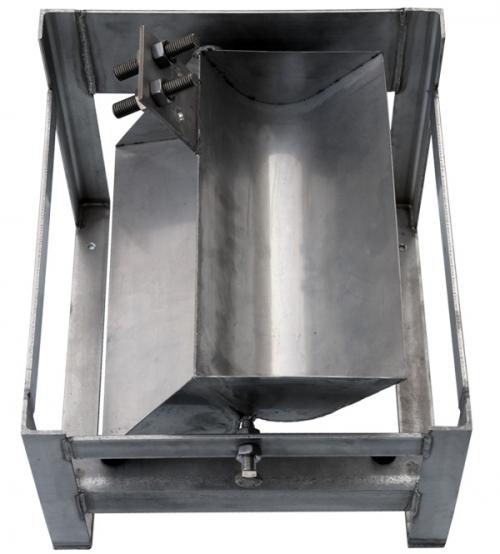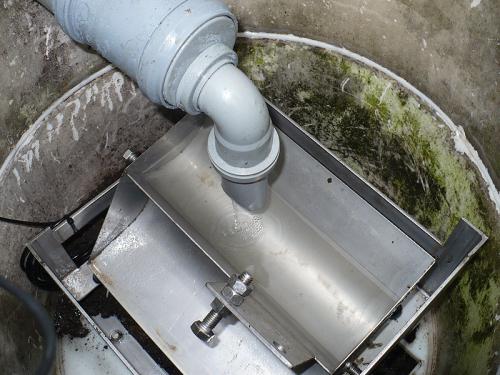PF500 shuttle tilt flow meter
Examples of use

The installation of the flow meter requires a height drop of at least 250 mm at the measuring point and a directed water supply above the center of the flow meter. On the other hand, the construction of the usual triangular specific overflow and the level sensor are eliminated. The flow meter also does not require any supply voltage and pulses can be recorded for a long time in a device powered only by a battery. The durable stainless steel design of the flowmeter is also not endangered by freezing, which endangers the sensitive membranes of hydrostatic level sensors.
Due to its simplicity and operational reliability, this type of flow meter can be used, for example, in the following applications:
- Leakage measurement in construction and geology
- Measurement of yield of small springs
- Measuring the amount of water flowing out of melting snow
- Measuring the amount of drainage water
Basic description
The robust stainless steel construction of the PF500 flowmeter contains two interconnected trays with a capacity of 2x 750 ml, which are mounted on a rotating shaft. Using rubber stops and balancing fittings, the flow meter is set so that the trays are tilted at a water volume of 500 ml. Each tilting of the trays causes a short closing of the relay contacts, which is then stored in the connected recording unit.
In conjunction with the telemetry unit M4016, H1, H7 or STELA, this robust flow meter can be used to monitor the instantaneous flow and to calculate the total flow, including automatic transfer of measured data to a database on the Internet and graphical and tabular visualization of measured flows and volumes.
One of the first designs of a shuttle flow meter in practice
Installation and recalibration
The basic calibration of the flow meter is performed by adjusting the height of the rubber stops and moving the balancing fitting before the flow meter is shipped in production. If the flowmeter is placed in a horizontal position using height-adjustable feet during installation, then no additional calibration will be necessary for about 1 year from installation (time depends on the frequency of tilting) and only the pulse volume constant needs to be set in the connected recording unit. which is supplied with the device - the usual value of this constant is 500 ml / pulse)
Due to the seating and wear of the rubber stops, the set volume constant may change after a certain period of operation. The operator can easily recalibrate the PF500 rain gauge on his own without having to change the stop settings and balance of the rain gauge. During such recalibration, it is sufficient to slowly pour water from the measuring cylinder into the trays of the rain gauge and then to store the average value from several such measurements in the volume constant in the connected recording device.
Parameters
Shuttle volume: approx. 500 ml (calibration constant adjustable in the connected unit)
Flip detection: magnetic switching contact of the reed relay
Relay contact: max 50 mA, 30V
Pulse length: min 25 mS
Shuttle material and supporting structure: stainless steel
Stainless steel ball bearing bearings
Maximum flip frequency: 10 flips / min
Max. recommended measurable flow: 5 l / min
Dimensions: 300 x 300 x 250 mm
Weight: 2.2 kg
Main menu
- Solutions
- Tap water treatment
- Dispatching accessible via the Internet
- Remote water meter reading
- Monitoring of water leak
- Measurement of qualitative water parameters
- Measurement in Water Supply Network
- Pressures and flows regulation
- Controlling of water pumps and water reservoirs
- Controlling technology of waste purification plants
- Flow processing into charts
- Waste water treatment
- Monitoring of running and technology of WWTP
- Control technology of WWTP
- Measurement of waste water flow
- Dissolved oxygen measurement and aeration blowers control
- Measurement of chemical parameters of water
- Local control of pumping stations
- Remote control of pumping stations
- Root zone waste water treatment plants
- Dispatching accessible via the Internet
- Processing of measured flow data
- Water level monitoring
- Flood warning system
- Environmental monitoring
- Water level and flow monitoring in small water-courses
- Temperature measurement in bore holes and water basins
- Monitoring of soil humidity and temperatures
- Measurement of rain-fall quantity and intensity
- Level measurement in boreholes and remote data collecting
- Measurement of water temperature and conductivity in boreholes
- Measurement of well yield – pumping tests
- Water-level regulation in boreholes
- Capacity and intensity of drainage water
- Thermal balance in ecological constructions
- Meteorological stations
- Relative humidity and air temperature, rainfall, global radiating, atmospheric pressure, speed and direction of wind
- Satellite transfer while the GSM signal is unavailable
- Meteorological stations for agriculture and research institutes
- Extension of meteorological stations about special sensors
- Different type of tower constructions
- Data transfers into the Internet
- Special kinds of graphs for visualization
- Irrigation control systems
- Data collecting and processing
- Data hosting on the server
- Software MOST
- Parameterization of stations via the Internet
- Transferring of measured data into a current dispatcher programme
- Visualization and processing of data
- Data exports from the server into the PC
- Overview reports working-out and printing
- An automatic emails sending
- Types of SIM cards
- Operating costs of the telemetric station
- Industrial applications
- Tap water treatment
- Products
- Monitoring and control units for water supply
- Small telemetric stations and data loggers
- Smart Metering - remote meter readings
- Water level meters
- Hydrostatic level meters
- Radar level meters
- Ultrasonic level meters
- Level gauges for wells, boreholes and reservoirs
- Level float switches
- Equipment for pumping tests of boreholes and wells
- Local Warning Systems
- Flow meters for open channels
- Water quality sensors
- Meteorological stations and measuring sensors
- Accessories for control units and data loggers
- Boxes and cabinets for telemetry and control units
- Gel accumulators, batteries and backup sources
- AC power supplies and battery chargers
- Photovoltaic solar panels
- Antennas and extension cables
- Sensor cables, connectors and connecting expanders
- Communication signal converters and communication cables
- Mechanical mounting elements
- Industrial and residential water meters
- Server software and services
- References
- Support & Download
- About us
- Monitoring
- Datahosting
- OPTIMA Control unit
Documentation
Download
Application
no related solutions







